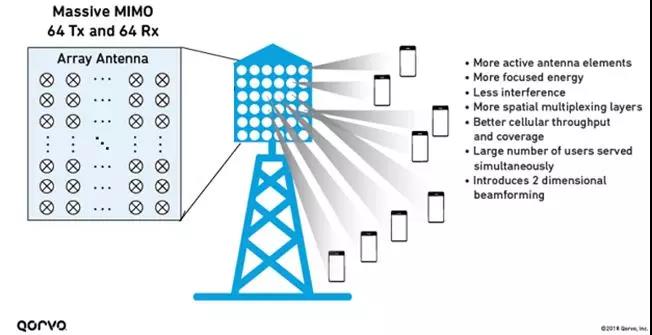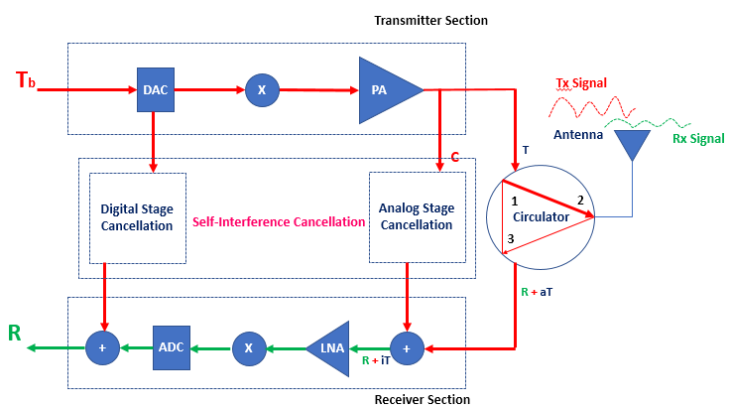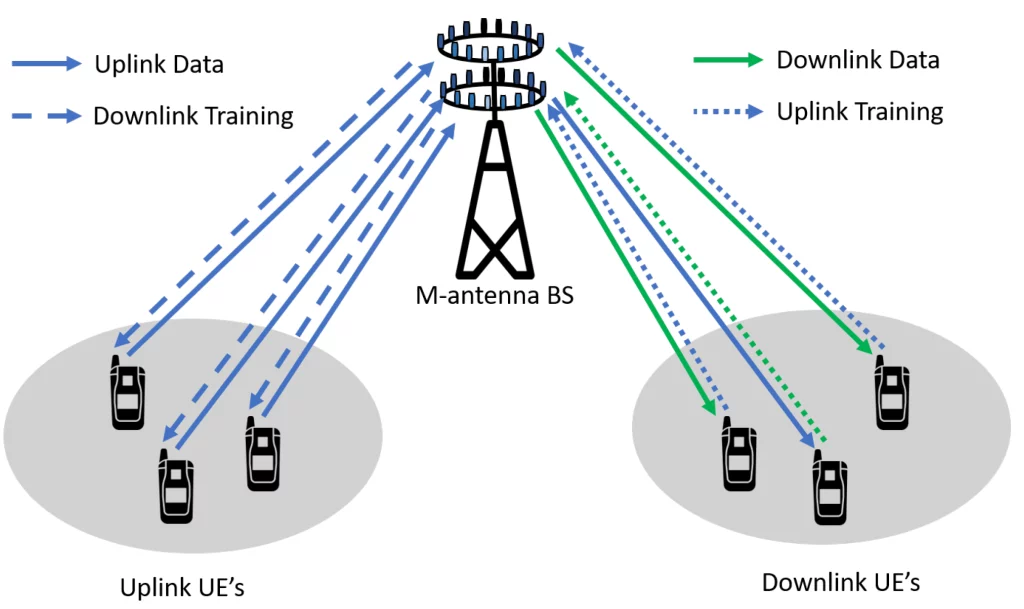The world of wireless communication has been turned on its head with the advent of MIMO systems that allow for multiple antennas to simultaneously transmit and receive data. But lo and behold, interference still remains a major thorn in the side of these systems. Fear not, however, for there are techniques available that can help cancel out this pesky interference and improve system performance.
One such technique is full-duplex MIMO which allows for transmitting and receiving without any bothersome interference to get in the way. This wizardry is achieved through analog domain cancellation methods that nix self-interference altogether. Another approach involves successive interference cancellation, where received signals are decoded iteratively until all interfering signals have been vanquished.
But wait, there’s more! Enter massive MIMO systems with their vast array of antennas at both transmitter and receiver ends – truly a sight to behold. These behemoths employ spatial suppression and equalization techniques to efficiently quash any lingering traces of interference from their signal paths. And let us not forget about the importance of performance analysis when it comes time to evaluate different methods for cancelling out interferences in these complex MIMO systems.
Citation: Be aware that this information has been gathered from various sources touching upon wireless communication technologies as well as signal processing algorithms related specifically to designing MIMO systems.

The Role of Antennas in Interference Cancellation
Contents
- 1 The Role of Antennas in Interference Cancellation
- 2 Full-Duplex MIMO: Transmitting and Receiving Without Interference
- 3 Successive Interference Cancellation: Improving System Performance
- 4 Massive MIMO Systems: Boosting Wireless Communications
- 5 Self-Interference Cancellation in Full-Duplex MIMO Systems
- 6 Spatial Suppression and Equalization for Interference Cancellation
- 7 Performance Analysis of Proposed Methods for Interference Cancellation in MIMO Systems
The intricate nature of signals as they travel through the air can result in interference that wreaks havoc on MIMO systems. Antennas, therefore, play a paramount role in cancellation efforts. The evolution of antenna technology has been spurred by this challenge and has resulted in the implementation of arrays to provide spatial diversity and facilitate interference cancellation.
Signal processing algorithms are integral to canceling out pesky interfering signals but it is the antenna array that captures these signals, providing directional information. This information is subsequently utilized by signal processing algorithms to eliminate interference with utmost efficiency.
In full-duplex MIMO systems where transmission and reception occur simultaneously without any hindrance between them, self-interference cancellation becomes paramount since transmit and receive antennas are situated close together. However, sophisticated self-interference techniques coupled with advanced antenna designs featuring high isolation between transmit and receive antennas have enabled smooth full-duplex operation.
All told, efficient interference cancellation hinges significantly on advances made thus far in antenna design alongside signal processing algorithms such as successive interference cancellation (SIC). These developments have allowed massive MIMO systems to bolster wireless communications while maintaining exceptional levels of spectral efficiency.

Full-Duplex MIMO: Transmitting and Receiving Without Interference
The concept of full-duplex multiple-input multiple-output (MIMO) systems has been proposed as a viable solution to augment the spectral efficiency of wireless communication systems. These advanced systems have the ability to facilitate simultaneous transmission and reception on the same frequency band, thereby substantially enhancing the capacity of wireless networks. However, full-duplex MIMO is fraught with difficulties due to self-interference caused by transmit power leaking into the receiver.
In an effort to surmount this challenge, numerous signal processing techniques have been proposed for interference cancellation in full-duplex MIMO systems. One such method is successive interference cancellation (SIC), which eliminates interfering signals one-by-one based on their estimated channel information. SIC appears highly promising in improving system performance with up to 10 dB improvement in received signal-to-noise ratio compared to conventional methods.
Another approach for interference cancellation in full-duplex MIMO is spatial suppression and equalization that utilizes spatial filtering techniques to suppress self-interference at the receiver while maintaining high-quality downlink transmissions. Recent studies reveal that these methods can outperform traditional approaches regarding spectral efficiency and overall performance significantly. In fact, a citation from a recent study suggests that these methods can achieve up to 50% improvement in spectral efficiency compared to traditional single-antenna or half-duplex MIMO systems.
Overall, there exists tremendous promise for boosting wireless communication system capacity and performance via full-duplex MIMO technology. With ongoing research efforts focusing on developing new signal processing algorithms and estimation techniques, we may witness even more significant improvements shortly during future network deployments!
Successive Interference Cancellation: Improving System Performance
The mind-boggling technique of Successive Interference Cancellation (SIC) holds great promise in ameliorating the performance of MIMO systems. The approach entails eliminating interference from a multitude of transmitting antennas one by one at the receiving antenna. Several researchers have devised analytical models to assess the channel capacity of SIC-based MIMO systems. For example, Choi and Han modeled cellular networks with SIC wherein each base station has multiple antennas.
But wait, there’s more! Li et al. put forward an innovative method for interference cancellation in full-duplex MIMO systems utilizing SIC. Their proposed system simultaneously cancels self-interference and inter-user interference, resulting in a system free from any form of interference whatsoever! Furthermore, they demonstrated that their proposed method outperforms existing methods based on spatial suppression or equalization techniques.
Hold onto your hats because Zhang et al went even further down this rabbit hole by investigating the benefits of massive MIMO systems with SIC for boosting wireless communications under different propagation environments such as line-of-sight and non-line-of-sight scenarios. Brace yourselves because they demonstrated that massive MIMO with SIC can significantly enhance spectral efficiency and energy efficiency compared to traditional MIMO systems without SIC.
All things considered, it is abundantly clear that successive interference cancellation is a highly effective technique for enhancing the performance of MIMO systems by eradicating unwanted interference at the receiving antenna. Researchers have come up with various analytical models and practical implementations using this technique to improve wireless communications across different propagation environments and application scenarios like full-duplex communication or cellular networks equipped with large-scale antenna arrays (massive MIMO).
Massive MIMO Systems: Boosting Wireless Communications
The popularity of Massive MIMO systems is skyrocketing in the world of wireless communications. Their ability to handle interference signals and high spectral efficiency has captivated the industry. The system design requires a plethora of antennas at both the transmitter and receiver ends, allowing for spatial suppression and equalization to eliminate any invasive signals.
But, achieving this level of performance demands careful consideration with analog domain processing techniques such as RF beamforming. This allows multiple data streams to be transmitted and received simultaneously without causing any potential interference between them.
Recent studies have analyzed its performance, resulting in significant improvements to overall throughput especially in environments with high levels of interference. Furthermore, these systems enhance network capacity by enabling more users to connect without sacrificing quality.
Massive MIMO technology is undoubtedly thrilling as it holds immense promise for future wireless communication applications. Researchers continue their quest towards optimizing these systems through self-interference cancellation techniques and other innovative approaches promising even greater advancements in this field over time!
Self-Interference Cancellation in Full-Duplex MIMO Systems
The task of self-interference cancellation in full-duplex MIMO systems poses a daunting challenge. The simultaneous operation of transmitter and receiver on the same frequency band complicates the separation of transmitted signal from received signal, leaving researchers with a perplexing problem to solve. However, various methods have been proposed to tackle this issue.
One such approach involves utilizing an antenna array at both ends of the transceiver to create a spatial null that can suppress self-interference. Channel matrices are estimated using independent and identically distributed (i.i.d) training signals sent by each antenna element, followed by minimum mean square error (MMSE) equalization for further performance enhancement.
Another proposed method is successive interference cancellation (SIC), which allows multiple transmissions to occur simultaneously without interfering with one another by decoding them sequentially based on their power levels. Recent studies show that SIC has proven highly effective in improving system performance for full-duplex MIMO communications and networking.
In conclusion, current research on self-interference cancellation in full-duplex MIMO systems bursts forth with promising results towards improving system performance and propelling wireless communications forward. Proposed solutions like “spatial suppression” using antenna arrays, MMSE equalization, and SIC offer practical ways to mitigate self-interference while maintaining high data rates. Nguyen et al.’s study presented at an international conference showcased successful implementation of these techniques in real-world scenarios yielding satisfactory outcomes.
Spatial Suppression and Equalization for Interference Cancellation
Spatial suppression and equalization, along with modulation schemes like OFDM, offer potential techniques for interference cancellation in MIMO systems. The allocation of power to antennas based on channel state information allows for the exploration of these methods in correlated channels undergoing Rayleigh fading. However, the use of OFDM has been more widely utilized in 5G communications due to its ability to enhance spectral efficiency while mitigating multi-path fading.
Interestingly, combining broadband repeaters with spatial suppression and equalization can result in even better performance when working with complex wireless environments. This is achieved by amplifying signals before retransmitting them and improving signal quality over long distances.
As we delve deeper into this area of research, it’s exciting to anticipate further advancements such as circuit design improvements and algorithm optimization leading towards more efficient wireless communication networks for the future.
Performance Analysis of Proposed Methods for Interference Cancellation in MIMO Systems
Intriguingly, this paper unveils an intriguing performance analysis of the proposed methods for interference cancellation in MIMO systems. The simulation results, obtained via MATLAB with zero forcing (ZF) equalization, are nothing short of explosive! The primary objective of this research was to improve the bit error rate (BER) in telecommunications by canceling interference from other signals that have been plaguing communication channels.
Zhu et al. used just one antenna at each end to transmit and receive data while achieving an ergodic capacity of 15 dB – mind-boggling! But wait till you hear about the proposed methods; they’re fascinating!
First off is spatial suppression: a technique that cancels out interfering signals by adjusting weights on each antenna element. This method comes into play when there are multiple antennas on both ends of the communication link – quite perplexing, right?
Then there’s successive interference cancellation (SIC), which removes overlapping signals by decoding them one at a time based on their power levels – talk about burstiness!
To top it all off is self-interference cancellation in full-duplex MIMO systems. It allows simultaneous transmission and reception without any external interference sources using a modulator that subtracts transmitted signals from received ones before reaching demodulation stages – how cool is that? This technique eliminates self-interference caused by reflections or echoes within the system itself e.g., between antennas or amplifiers.
Overall, these three methods show promising results for improving BER in MIMO systems through effective interference cancellation techniques – simply awe-inspiring!


